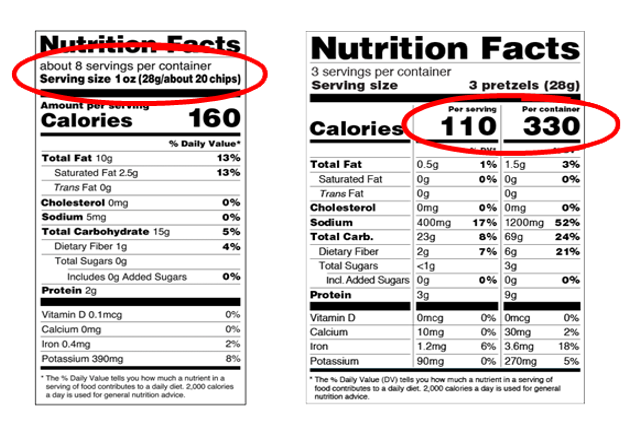
Size Matters...In Servings, Portions, and Plates
It’s fairly common knowledge that Americans are getting heavier. One of the biggest contributing factors is that portion sizes of food served outside the home (restaurants, movie theaters, amusement parks, etc.) have measurably doubled and sometimes tripled during the past 25 years.
As we get used to bigger portions outside our homes, it makes sense that we unconsciously start serving bigger portions at our own tables. The interesting thing is that serving sizes, regulated by the government, have stayed the same and in some cases have gotten smaller.
So, what’s the difference and how can we use that information to eat healthier and even shed a few pounds?
The Difference Between Portion Size and Serving Size
A portion is the amount of food that we choose to eat or serve for a meal or snack. It can be big or small depending on who is serving and who is eating. A serving is a measured amount of food or drink, such as one slice of bread or one cup (eight ounces) of milk.
Nutrition labels on food and drink carry serving sizes. The calories, often listed in bold numbers, are calories per serving. Many of us have noticed that a three ounce bag of chips, we could easily eat as a snack, contains 150 calories per serving. 150 calories for a snack isn’t bad.
But the bag contains 3 – 1 ounce servings, because it has been determined that one ounce is an appropriate serving for chips.
Similarly, a 20 oz soda, often bought as a single serving, is considered to be 2.5 – 8 ounce servings. Even if we are aware of this discrepancy, we are so used to buying single servings of food, we often eat and drink more than necessary without thinking. 25 years ago, snack sized chips actually came in one-ounce bags.
New FDA rules require food producers to put “calories per serving” and “number of servings” on its nutrition labels. But as illustrated below (left), calories per serving are much easier to see at a glance than the number of servings! Both pieces of information are necessary to really understand what we are eating.
New Food and Drug Administration (FDA) rules specify that the label on any food package that contains between two and three servings and that could be eaten in one sitting must provide nutrition information both for a single serving and for eating the entire contents (below right). But whether or not something can be eaten in one sitting is a judgement call, so full package info is not always available and we have to be vigilant.

My, How We’ve Grown!
While serving sizes have remained standard portions sizes have grown. Consider these sobering comparisons:

What can we do? Practice 20th Century Portion Size!
Compare Portions to Familiar Objects
Visual cues can be incredibly helpful in estimating portion sizes. Use everyday objects as reference points to gauge appropriate portion sizes.
• A serving of meat, poultry, or fish should be roughly the size of a deck of cards
• A serving of pasta or grains should be about the size of a tennis ball
• A serving of cheese should be similar in size to a pair of dice.
• A serving of fresh vegetables can pretty much be as big as you’d like, but two handfuls is a good guide.
Actually, using our hands as a guide is a “handy” way of remembering portion size basics.

Downsize Your Plates and Bowls
Research suggests that people tend to consume more when using larger plates and bowls. By using smaller plates and bowls, you will naturally reduce the amount of food you serve yourself. This simple switch can help control portion sizes and prevent overeating.
Be Mindful When Eating Out or Ordering Takeout
When out to eat, consider splitting an entree or ordering a few dishes to share among the group. Request a to-go box right when your meal arrives, and immediately portion out a suitable amount to take home, ensuring you don’t overeat in one sitting.
The Bottom Line:
Adjusting, or resetting our ideas about portions can go a long way towards helping us meet our health goals. A simple change in perspective can help you shed pounds and save money!
• Remember serving size is standard, so look at serving size, not just calories, when eating packaged foods.
• Your hand is always “handy.” Use it to remind yourself about portion control. What may seem small at first, will seem normal in a couple of weeks. Especially if you put food on smaller plates.
• Remember that 25 years ago, one half of today’s bagel or cheeseburger would have filled you up. So feel free to cut things in half and share with a friend or save for later.